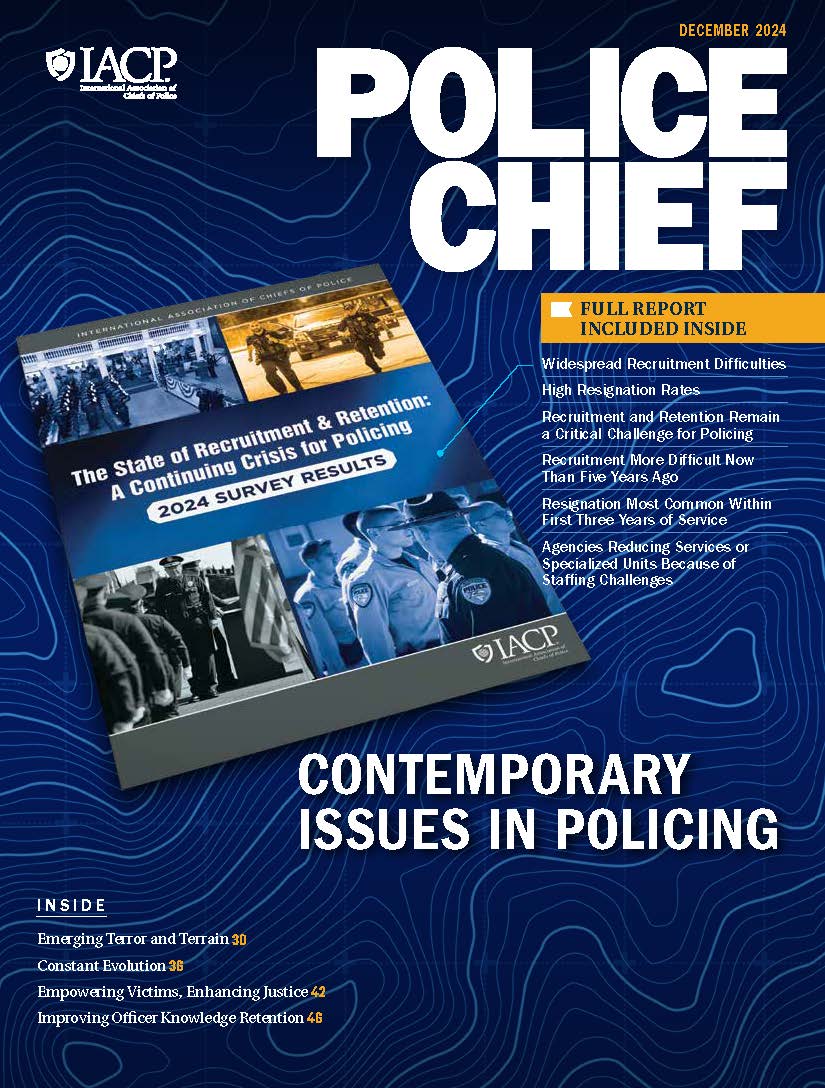The last several years have been challenging for law enforcement. In August 2018, preliminary 2018 data show that fatalities in law enforcement were already up by more than 10 percent over 2017 and that firearms-related deaths increased by more than 32 percent.1 Additionally, mental health issues continue to plague the profession. In 2017, 140 police officers died by suicide, whereas 129 police officers died in the line of duty.2
Law enforcement as a profession has a desire and a responsibility to improve officer safety and wellness. The State of Policy in Law Enforcement 2018 report found that 80 percent of law enforcement agencies within the United States expressed an increased need for training.3 Initiatives like that of the U.S. Department of Justice, Bureau of Justice Assistance (BJA) VALOR Officer Safety and Wellness Training and Technical Assistance Program are working to fill this need by delivering comprehensive, up-to-date, dynamic training with the ultimate goal of improving officer health and wellness.4
While education and training have always served as critical foundational elements for law enforcement, they are even more relevant in today’s society. Advanced training technologies and techniques have the potential to equip officers with the right combination of knowledge and skills, improving the safety and effectiveness of law enforcement and benefiting communities worldwide.
A Dynamic Environment
In today’s evolving world, law enforcement is faced with staying up-to-date on a wider range of issues than ever before. Agencies agree that education and training are critical needs; however, adopting techniques that keep pace with an onslaught of new and updated policies can be a challenge.
Traditionally, law enforcement training has centered around an instructor-led classroom setting. In recent years, this “learn by lecture” standard has been challenged by a combination of factors. Many agencies have been driven to reevaluate the effectiveness of training techniques and embrace new technologies to advance their practices.
 A core driver in this reevaluation are technology-based and issue-based policies for modern police practice.5 While some policies are a result of the need to adapt to modern technologies, like those regarding unmanned aerial systems (UAS) and body-worn cameras, issue-based policies focusing on topics like responding to transgender individuals and people in crisis come from societal changes. Still others, like use-of-force policies, are a result of the need to proactively respond to increased scrutiny on and community concerns about law enforcement. With laws and standards constantly in flux, it is important for law enforcement agencies to regularly review and update their policies and procedures, as well as their training practices, to ensure the safety and effectiveness of their officers.
A core driver in this reevaluation are technology-based and issue-based policies for modern police practice.5 While some policies are a result of the need to adapt to modern technologies, like those regarding unmanned aerial systems (UAS) and body-worn cameras, issue-based policies focusing on topics like responding to transgender individuals and people in crisis come from societal changes. Still others, like use-of-force policies, are a result of the need to proactively respond to increased scrutiny on and community concerns about law enforcement. With laws and standards constantly in flux, it is important for law enforcement agencies to regularly review and update their policies and procedures, as well as their training practices, to ensure the safety and effectiveness of their officers.
Technology has also changed the way law enforcement interacts with the community. With the advent of social media and the speed at which information is currently shared, agencies must become earlier adopters of new technology in order to stay relevant and continue to lead the communities they serve.
A changing workforce is another driver in the evolution of training. Millennials now represent 35 percent of the U.S. workforce, making them the largest generation in the workforce today.6 When it comes to training and education, millennials’ learning styles differ greatly from traditional techniques. While a classroom environment may be the preferred method for baby boomers and even members of Generation X, the millennials often prefer a less formal learning environment. In fact, a 2017 study demonstrated that millennials would like to spend 12 percent less time on in-classroom training.7 As the “digital native” generation, millennials learn by seeing and doing, as opposed to hearing. To meet the needs of this new generation of officers, traditional training techniques must be complemented by appropriate hands-on learning.
Training and Education Techniques
With the continual shift in policies and an evolving workforce, law enforcement agencies must proactively work to raise the bar. However, one of the most common challenges faced by agencies today is the reduction of training budgets. Newer training techniques take advantage of today’s technology and help agencies extend training dollars while addressing contemporary issues.
Bite-Sized Learning
Traditional classroom environments still exist; however, many agencies are beginning to reduce the length of time spent in the classroom. Rather than conducting lecture-style training for several hours or even full-day or multiday blocks, “bite-sized learning” takes place in shorter, more condensed periods of time. According to the Journal of Applied Psychology, learning in bite-sized pieces makes the transfer of learning from classroom to desk or field work 17 percent more efficient.8 This learning style also reduces significant administrative personnel resources typically spent conducting in-depth training sessions and ensures law enforcement officers can spend their time on high-priority work, while staying engaged and up-to-date in their understanding of the latest need-to-know trends and policies.
Video
Video has the ability to change the game for law enforcement training practices and with good reason. Video can be quickly understood and applied to real-life situations. It has been proven that the brain can process video 60,000 times faster than text.9 Additionally, for agencies whose budgets are already stretched, video is a great way to maximize training practices on limited funding. Training videos can be viewed together—in the company of a department supervisor—or during a shift from an officer’s mobile phone when there is downtime.
At the University of Central Florida, on-demand videos are a recent addition to the agency’s training regimen. Brief videos, no more than 12–15 minutes long, are uploaded regularly to its online policy and training management system, keeping officers and other personnel up-to-date on changes in training or policy. The videos are viewed at the officers’ discretion and signed off on within the system to confirm the training is complete.
Online Training Courses
As agencies seek to stretch their training dollars further and make training more effective, many have also turned to online training. Online training software lets agencies create customized courses that their employees can complete on their own time. According to a study by Brandon Hall Group, online training takes 40 to 60 percent less employee time than learning the same things in a classroom.10 When officers are completing training on their own time, there are fewer distractions. Similarly, they don’t need to be pulled away from their work or set aside specific days for company-wide classroom-style training. Much like video, online training also frees up administrative personnel hours. Administrators no longer have to coordinate schedules, identify instructors for each training session, or track down classroom space.
Penny Phelps, the captain of special operations at Monroe County Sheriff’s Office in Florida, remembers a time when Monroe County officers had to sit through three 12-hour days of redundant classroom training. She says deputies dreaded the training days, which ate into the time for hands-on training.11 When Monroe County converted to online training, deputies were able to do all the training online. Instead of spending 36 hours sitting in a classroom listening to lectures, officers complete those courses on their own time.
Monroe’s in-person retraining now takes just four hours, all of which is devoted to practical, scenario-based training. Officers take the information they learned in the online courses and practice putting their skills to use. Phelps says the staff now enjoys participating in training, rather than dreading it.
Hands-On Learning
Hands-on learning has always been a critical component of officer training, but now there are new ways to better prepare officers for real-life scenarios. Many agencies are exploring the integration of video into hands-on learning to maximize the training’s effectiveness. By leveraging captured video from a real-world active shooter crisis, for example, agencies are able to incorporate a recent incident into tactical response training. The video prepares officers with the proper mind-set and makes it clear that the incident will be stressful, chaotic, and dangerous and that no perfect plan exists. The hands-on training then creates the muscle memory needed for a tactical response of running toward the gunfire while everyone else at the scene is running away. Similarly, new simulation technologies are being introduced to put officers in life-like scenarios to practice decision-making skills and tactical response time.
Resilience Training for Mental Wellness
 Training can also have a direct impact on officers’ mental health and wellness; an element that should not be overlooked. Mental health issues and suicide have increasingly come to the forefront as the numbers of those affected within the profession continue to grow. Compared to the general population, law enforcement officers report much higher rates of depression, PTSD, burnout, and other anxiety-related mental health conditions.12
Training can also have a direct impact on officers’ mental health and wellness; an element that should not be overlooked. Mental health issues and suicide have increasingly come to the forefront as the numbers of those affected within the profession continue to grow. Compared to the general population, law enforcement officers report much higher rates of depression, PTSD, burnout, and other anxiety-related mental health conditions.12
The VALOR program is just one initiative proactively working to address this issue. It provides law enforcement officers with a range of free, dynamic training opportunities that focus on how to cope with dangerous situations, techniques for defusing difficult encounters, and other resources to help cultivate a culture of safety.13
The National Alliance on Mental Illness is another great resource for agencies. It worked with the U.S. Department of Justice after the Sandy Hook Elementary School shooting in Newtown, Connecticut, to develop a detailed guide, Preparing for the Unimaginable, for law enforcement leaders to reference in discussing mental health before and after mass casualty events.14
Resilience should be a core focus for law enforcement leaders and colleagues seeking to prevent mental health crises among law enforcement and proactively addressing existing issues or those that surface. The IACP has several initiatives underway to provide law enforcement with outstanding best practices to address these issues.15
Communications and Accountability
There is no longer a gap between the time a dangerous incident occurs and the time the news broadcasts it. The real-time nature of these events has increased the visibility of law enforcement in the public eye and puts added pressure on law enforcement to be held accountable for training practices—to ensure officers are prepared for crises. Additionally, agencies must ensure its officers are updated on new and evolving policies, and that they are trained on the proper way to handle them in the event of an incident. Communication is critical in this process.
Traditionally, many agencies have used paper for tracking training practices, having their officers sign off on new policies or procedures. But with the advent of new training techniques, particularly video and online training, the implementation of an electronic management system is a critical step in becoming more compliant and accountable. Such a system also ensures that policies and training videos are updated and disseminated quickly, saving agencies a significant amount of time and money.
Additionally, video often serves as a best practice in information sharing. In the event of an incident, for example, an active-shooter situation or a civil discourse crisis like the one that took place in Charlottesville, Virginia, in 2017, law enforcement agencies are sharing information almost immediately afterward. These real-life scenarios can then be utilized in video training, so that other agencies can learn from what worked and what didn’t when responding to a crisis situation.
Making the Correlation: Training, Safety, and Effectiveness
There are several considerations when determining the best type of training for law enforcement agencies, particularly the type of community an agency serves, the level of expertise across its staff, and the most common incident types in the jurisdiction. However, agencies cannot wait for surprise situations to come to them before training their officers. Law enforcement must proactively work to ensure officers are well-informed and well-prepared at all times. This will enable them to ensure a strong level of constitutional policing and increase public and officer safety. d
Notes:
1 National Law Enforcement Officers Memorial Fund, “Preliminary 2018 Law Enforcement Officer Fatalities,” August 5, 2018.
2 Ruderman Family Foundation, “Study: Police Officers and Firefighters Are More Likely to Die by Suicide Than in the Line of Duty,” April 2018.
3 PowerDMS, State of Policy in Law Enforcement 2018, October 2018.
4 Valor Officer Safety and Wellness Program.
5 PowerDMS, State of Policy in Law Enforcement 2018.
6 Pew Research Center, “Millennials Are the Largest Generation in the U.S. Labor Force,” April 2018,
7 Robert J. Kelly, Research Report: Salesperson Learning Preferences (Atlanta, GA: Sales Management Association, Inc., 2017).
8 Karla Gutierrez, “Numbers Don’t Lie: Why Microlearning Is Better for Your Learners (and You Too),” SHIFT eLearning Blog, September 27, 2018.
9 Liraz Margalit, “Video vs Text: The Brain Perspective,” Wondermouse (blog), July 13, 2017.
10 Autumn Lewis, “The Business Case for Online Training,” Digitec Blog, January 26, 2018.
11 Penny Phelps, Special Operations, Monroe County Sheriff’s Office, Implementing Scenario-based Training in your Agency Webinar, Jan. 26, 2016
12 Gordon J.G. Asmundson and Jennifer A. Stapleton, “Associations Between Dimensions of Anxiety Sensitivity and PTSD Symptom Clusters in Active-Duty Police Officers,” Cognitive Behaviour Therapy 37, no. 2 (2008): 66–75.
13 Valor Officer Safety and Wellness Program.
14 Laura Usher et al., Preparing for the Unimaginable: How Chiefs Can Safeguard Officer Mental Health Before and After Mass Casualty Events (Washington, DC: Office of Community Oriented Policing Services, 2016).
15 Bureau of Justice Assistance, “VALOR Initiative: Officer Robert Wilson III Preventing Violence Against Law Enforcement Officers and Ensuring Officer Resilience and Survivability.”
Please cite as
Richard Beary, “Strengthening the Foundation: How New Trends in Training Can Improve Officers’ Safety and Effectiveness,” Police Chief online, November 7, 2018.



